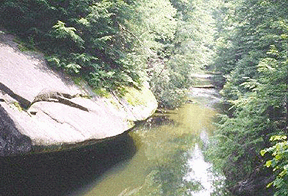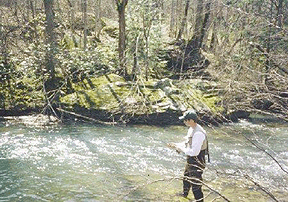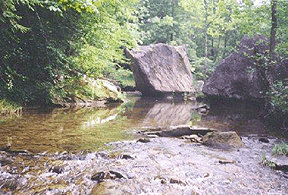Story and Photos by Andre Bergeron Traveling west on Highway 92, passing through Whitley County, Kentucky and then into McCreary County, one initially observes a less than glamorous slice of Americana. The Big South Fork National River and Recreation Area, which is part of the Daniel Boone National Forest, straddles the Kentucky-Tennessee border. This region has led to some stereotyped depictions of both Tennessee and Kentucky. Washing machines and old hot-water heaters adorn the porches of many houses along these back roads, while trailers and collapsing shacks are scattered about the landscape. However, just as one can not judge a book by its cover, one can not base a conclusion on the character of McCreary County's residents by their dwellings. Each time I've made a wrong turn and stopped for directions, and each time I've asked locals to point the way to good fishing, I've always been courteously attended to. And yet, the question still arises: Why is this pure wilderness area's entrance bespeckled by such man-made eyesores that visitors must drive past? To this query I submit the fact that to get to Australia, a 24-hour flight is necessary. A lengthy, arduous drive is required to take the kids to Disney World. And don't you have to go through highly commercialized Pigeon Forge or Gatlinburg to get to the serenity of the Smoky Mountains. Surely, any worthwhile destination merits a few trials and tribulations.
I come to Rock Creek for many reasons. I long for solitude. I crave the undisturbed beauty of the woods. I want to enjoy the harmony of a healthy stream running its course. It has often been said that Rock Creek is one of the few, perhaps the only, bodies of water in Kentucky that has all the characteristics of a natural mountain trout stream. As a native of East Tennessee who grew up near the Smoky Mountains, I will take every chance I get to visit anything that resembles the landscape of my youth.
Most of my experience comes from the region near the headwaters of Rock Creek. First of all, the lower stretch is often crowded with bait fishermen standing on the banks, chucking worms and bobbers down into the depths of the long, slow pools. I have nothing against this method, but I prefer to wade into the middle of a stream, to fight the currents, to navigate the slippery rocks and drop-offs, to become just another object in the water. When practicing this type of wading stealthily, one can often come within a few feet of lounging trout. Undoubtedly, these are young stockers who haven't yet gained the wisdom of a few years spent avoiding the many hazards of stream life. When wading the shallow portions of Rock Creek, I slowly make my way to the back of a pool and cast a dry fly upstream into the head of the pool. When fishing with dries, I usually use a caddis or cahill, as I have seen many of these in hatches, and have had decent luck with this type of fly. There are immense boulders, some larger than houses, scattered throughout the creek and its banks. (Perhaps this is where the name "Rock" Creek comes from.)
The air is calm around Rock Creek. An occasional bird call and the constant murmur of the stream might be the only noise heard during an entire day. Also, my reflection in a still pool could be the only other human face I see. For the fly fisherman seeking such an experience, Rock Creek in the Big South Fork is a perfect location. However, I often go with a fishing partner, and I would recommend taking along such a friend with similar skill and temperament. Though the tight casting in some parts of the creek can be frustrating, the rewards of a pleasant, enjoyable day are best shared with a good friend. There is another reason for going with a companion — the wildlife. As I have said earlier, this region very closely reproduces the experience of being in the mountains of East Tennessee. Those conditions are more complete than just similar streams with similar fish. Wild boar are plentiful in the Big South Fork, where they used to be hunted for sport. And in the past few years, black bear have been reintroduced to this area — which was once their domain. These two species could potentially pose a threat to the unwary, lone fisherman, though it is unlikely. To be on the safe side, take a friend or keep constant vigilance about your surroundings. Besides fishing, canoeing and kayaking are possible on many portions of Rock Creek. Further activities include numerous hiking trails throughout the Big South Fork region that lead to scenic vistas and high mountain ridges overlooking vast stretches of the park. Access to nearly every part of the park, and to Rock Creek is excellent. Rock Creek provides over 15 miles of public water, and almost all of this distance is directly paralleled by Forest Service Roads 566 and 137. How to Get to Rock Creek: From the North: If you are coming from points North in Kentucky, travel via HWY 27 South or I-75 South. In both instances, you will get off onto HWY 92 West. This will take you past the town of Stearns. You will eventually cross a bridge that goes over the South Fork of the Cumberland. Immediately after getting off this bridge, turn left onto KY 1363. Follow 1363 till the White Oak Junction, where you will turn left onto Forest Service Road (FS)566. This road runs next to Rock Creek for 7 or 8 miles. At the Bell Farm intersection, turn left onto FS 564 for a mile or so, then another left onto FS 137, which follows the rest of Rock Creek up to its headwaters. *(Much of these FS roads are gravel, and fairly bumpy, but a 4-wheel drive vehicle is not needed. Occasionally you might have to get out and move a fallen tree or similar obstacle to get by. It is my opinion that this just adds to the adventure.) From the South: Take I-75 North till around Williamsburg (about 10-15 minutes north of the Tennessee border). Get off onto HWY 92 West and follow the directions above. **A very detailed map would be a good idea, because the smaller roads, and especially the gravel Forest Service roads, can sometimes be confusing. They are not always marked very well. If you have the patience to get lost a few times, you will be rewarded when you find Rock Creek and all its natural splendor. Andre Bergeron is a freelance writer/ photographer living in Louisville, Ky. and a native of East Tennessee. He's a graduate student at the University of Lousiville and an avid flyfisherman, a member of Trout Unlimited. 
For an introduction to our Secret Vistas department, please see the inaugural issue, or take the:
Copyright © The Southerner 1999.  |




















